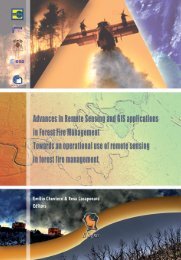EARSeL Newsletter - EARSeL, European Association of Remote ...
EARSeL Newsletter - EARSeL, European Association of Remote ...
EARSeL Newsletter - EARSeL, European Association of Remote ...
Create successful ePaper yourself
Turn your PDF publications into a flip-book with our unique Google optimized e-Paper software.
<strong>EARSeL</strong> <strong>Newsletter</strong> September 2002 - Number 51<br />
28<br />
ters on the US DMSP (Defence Meteorological<br />
Satellite Programme) satellites up to F-<br />
14, launched in April 1997.<br />
In the opinion <strong>of</strong> the reviewer, the most interesting<br />
part <strong>of</strong> the book is the final chapter,<br />
dealing with "microwave observations<br />
<strong>of</strong> processes in the ocean-atmosphere system".<br />
It presents results <strong>of</strong> experiments carried<br />
out from ships and aircraft, <strong>of</strong> the<br />
phenomena previously dealt with. Internal<br />
waves were studied in a cruise on the Indian<br />
Sea (1981), with a radiometer-scatterometer<br />
at 37 GHz (vertical polarisation) and a<br />
radiometer at 1.7 GHz (horizontal polarisation)<br />
operated at an angle <strong>of</strong> incidence <strong>of</strong><br />
75º. Another experiment was carried out<br />
with a 37 GHz radiometer (vertical polarisation)<br />
and a high-resolution echo-sounder<br />
recording internal solitons in the Sea <strong>of</strong><br />
Japan (1981). Still other experiments were<br />
carried out in the Atlantic Ocean (near<br />
Long Island) in a Joint USA / Russia Internal<br />
Wave <strong>Remote</strong> Sensing Experiment<br />
(JUSREX, 1992) with the "aircraft laboratory<br />
Tupolev-134" equipped with a real-aperture<br />
radar at 13 GHz and radiometers at<br />
1.6, 3.9, 20 and 37 GHz. Rather convincing<br />
results are presented and commented on.<br />
One section deals with the surface effect <strong>of</strong><br />
rain. Rain changes both the surface salinity<br />
and occasionally also its temperature,<br />
which changes the ripple structure on the<br />
ocean surface and thereby the microwave<br />
thermal emission. Examples show that the<br />
effect is limited in time to an hour or so.<br />
Ship-borne measurements (1984) with a radiometer<br />
system at 48, 37, 34 and 20 GHz, all<br />
vertical polarisation, and another channel at<br />
37 GHz, horizontal polarisation, reveal the<br />
rather surprising result that the "relic rain" is<br />
observed at all frequencies except 20 and 37<br />
GHz, vertical polarisation.<br />
The author spends a few pages discussing<br />
the reason for the observation that the effect<br />
is seen on one frequency and not another,<br />
only 3 GHz away – unfortunately not very<br />
convincingly. In contrast, a so-called tropical<br />
shower (20 mm/h) may be seen on all<br />
frequencies and polarisations: at 34 GHz,<br />
horizontal polarisation the brightness temperature<br />
increases by more that 100 K.<br />
Similarly, a frontal zone was detected by<br />
the ship-borne radiometer / scatterometer<br />
at 37 GHz in the Pacific Ocean (1983), revealing<br />
strong ‘signatures’ <strong>of</strong> more than 20<br />
K and 10 dB in one case, and about 3 dB in<br />
another. An oceanic synoptic ring was<br />
recorded from a radiometer on a TU-134 research<br />
aircraft at 37 and 48 GHz, but not at<br />
20 and 75 GHz (1990). The cyclone Warren<br />
(1984) gave surface effects that were observed<br />
at 48 and 34 GHz, but not on 20 and<br />
37 GHz (all vertical polarisation). Finally,<br />
SMM/I data (1997) revealed an interesting<br />
signature in a 600 kilometres long area<br />
along the continental break in the northern<br />
part <strong>of</strong> Norwegian Sea.<br />
In some <strong>of</strong> the cases presented, the observations<br />
are supported by simultaneous oceanic<br />
and meteorological data. In other cases<br />
they are discussed in the context <strong>of</strong> oceanic<br />
research in the area in question, <strong>of</strong>ten carried<br />
out by Russian research vessels.<br />
This interesting but specialised book is a revision<br />
<strong>of</strong> a previously published book<br />
(1994, in Russian) with some additions <strong>of</strong><br />
which the SMM/I data are worth mentioning.<br />
The observations presented are thoroughly<br />
discussed in an oceanic context,<br />
referring to a great number <strong>of</strong> relevant research<br />
papers. In fact, the extensive list <strong>of</strong><br />
references (over 275) is a valuable source <strong>of</strong><br />
information about oceanic and meteorological<br />
research carried out in Russia, many <strong>of</strong><br />
which have been translated into English.<br />
The book has some shortcomings, in that<br />
the language is rather elaborate; at few<br />
places sentences (apparently interpreted<br />
from Russian) are difficult to understand<br />
by another foreigner.<br />
5.2 Book: study <strong>of</strong> Kara Sea, Russian<br />
Arctic<br />
Polar Seas Oceanography: An Integrated Case<br />
Study <strong>of</strong> the Kara Sea. Authors: Vladimir A.<br />
Volkov, Ola M. Johannessen, Victor E.<br />
Borodachev, Gennadiy N. Voinov, Lasse H.<br />
Pettersson, Leonid P. Bobylev and Alexei V.<br />
Kouraev. May 2002. Praxis Publishing Ltd.<br />
496 pp., including 12-page colour section.<br />
ISBN: 3-54042-969-7. List price: 104.50 Euros.<br />
The Kara Sea <strong>of</strong> the Russian Arctic, with its<br />
unique oceanographic regime, is a site <strong>of</strong>
















